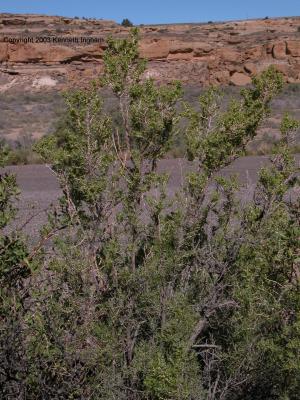
Greasewood: Sarcobatus vermiculatus
| Description: | Greasewood is a 1-2 meter-tall shrub that is found growing throughout New Mexico and the Southwest on saline or alkaline soils. We've observed it in great profusion in Chaco Canyon. The green fruits are small, but distinctive and it has linear, fleshy green leaves. | ||||||||||||||
| Botanical Characteristics: |
| ||||||||||||||
| Habitat and range: | Occurs from Canada to Mexico in the western U.S., from Washington to North Dakota and New Mexico to California. See entry in the US Department of Agriculture Plants Profile. No county distribution maps are available at the USDA site, but range information is available in Carter (1997) and Ivey (1995). | ||||||||||||||
| Growth habit: | Shrub | ||||||||||||||
| Status: | Invasive weed. | ||||||||||||||
| Ecology: | The numerous seeds are wind-dispersed and help to re-establish the plants after fire, although greasewood is only slightly harmed, if at all by fire, and will resprout. Greasewood is forage for many animals including: jack rabbits (major food item), prairie dogs, California quail, and pronghorn (Elmore, 1976). The plants are provide shade and protective cover for many small mammals. | ||||||||||||||
| Human uses: | Indians used the seeds and leaves, which taste salty, for food (Elmore, 1976). The Hopi and other Native Americans use greasewood for fuel and for planting sticks (USDA Plant Profiles). In Chaco Culture National Historical Park greasewood was used for construction, especially of lintels, for fuel, being a preferred wood for Pueblo kiva fires (NPS, n.d.). |
More information and pictures:
 | Overview of greasewood plant. Note the rigid, spreading branches. This
photo was taken on the Wijiji ruin hike at
Chaco Culture National Historical Park, New Mexico.
|
Closeup of greasewood plant. Note the linear, fleshy leaves and the fruit
with green, membranous wings. This photo was taken on the
Wijiji ruin hike at Chaco Culture National
Historical Park, New Mexico.
Used for an exhibit at the non-profit Great Basin Visitor Center in Baker, NV. |  |
Taxonomy:
| Kingdom | Plantae---Plants |
| Subkingdom | Tracheobionta---Vascular plants |
| Superdivision | Spermatophyta---Seed plants |
| Division | Magnoliophyta---Flowering plants |
| Class | Magnoliopsida---Dicotyledons |
| Subclass | Caryophyllidae |
| Order | Caryophyllales |
| Family | Chenopodiaceae---Goosefoot family |
| Genus | Sarcobatus Nees---greasewood |
| Species | Sarcobatus vermiculatus (Hook.) Torr.---greasewood |
References:
Carter, Jack L. 1997. Trees and Shrubs of New Mexico. Boulder, CO: Johnson Books, distributor.
Elmore, Francis H. 1976. Shrubs and Trees of the Southwest Uplands. Popular Series No. 19. Globe (AZ): Wouthwest Parks and Monuments Association.
Ivey, Robert DeWitt. 1995. Flowering Plants of New Mexico. 3rd ed. Albuquerque: Robert DeWitt Ivey.
Anon. n.d. Native Plants of Chaco Canyon: A Self-Guided Courtyard Walk . Chaco Canyon, NM: Chaco Culture National Historical Park, National Park Service.
|
Copyright © 1997-2018 Kenneth Ingham Consulting, LLC.
For details about the copyright, see the full Copyright statement.
Unhappy? Thinking of suing us? Read this disclaimer.
You can read our privacy statement.